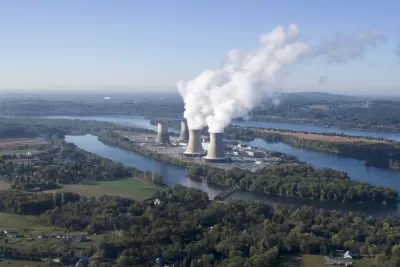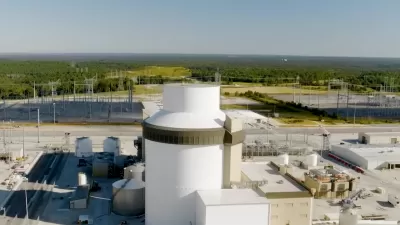Nuclear regulators have recently given the green light to a new kind of nuclear reactor, the small modular reactor. A recent article in The Urbanist explains the case for a nuclear-powered urbanism.

Shaun Kuo provides news and commentary about innovation in the nuclear power sector that might position nuclear power as a resource for the goals of urbanism.
First, the news: The "Department of Energy recently approved a multi-year cost share award of up $1.355 billion to a new entity, the Carbon Free Power Project, to demonstrate and deploy a 12-module small modular reactor (SMR) power plant," according to Kuo. That funding award follows additional news from August that the U.S. Nuclear Regulatory Commission gave first-ever design approval for an SMR for a power plant expected to be built by 2029. NuScale Power designed the 720-megawatt plant, and Utah Associated Municipal Power Systems (UAMPS), which owns the Carbon Free Power Project, hopes to begin construction on the SMR by 2025 at its planned location at the Idaho National Laboratory.
"UAMPS will be distributing energy from the plant to their participating public power utility customers in Utah, California, Idaho, Nevada, New Mexico, and Wyoming. UAMPS CEO noted that this project will complement and enable additional intermittent renewable energy, wind and solar that are a growing part of the agency’s portfolio," according to the article.
After explaining how SMRs differ from the nuclear reactors of history, Kuo ties those distinctions to a question of density, and suggests that SMRs enable a community-level approach to the future deployment of nuclear power. "Whether or not SMRs fit into the niches demanded by our urban areas, it will have to depend on the needs of each community to develop energy portfolios," writes Kuo.
FULL STORY: An Urbanist Case for Small Nuclear Power Reactors

Maui's Vacation Rental Debate Turns Ugly
Verbal attacks, misinformation campaigns and fistfights plague a high-stakes debate to convert thousands of vacation rentals into long-term housing.

Planetizen Federal Action Tracker
A weekly monitor of how Trump’s orders and actions are impacting planners and planning in America.

San Francisco Suspends Traffic Calming Amidst Record Deaths
Citing “a challenging fiscal landscape,” the city will cease the program on the heels of 42 traffic deaths, including 24 pedestrians.

Detroit Says Problems With Property Tax Assessments are Fixed. Advocates Disagree.
With higher-valued properties under assessed and lower-valued properties over assessed, advocates say there's still a problem with Detroit's property tax system.

Defunct Pittsburgh Power Plant to Become Residential Tower
A decommissioned steam heat plant will be redeveloped into almost 100 affordable housing units.

Trump Prompts Restructuring of Transportation Research Board in “Unprecedented Overreach”
The TRB has eliminated more than half of its committees including those focused on climate, equity, and cities.
Urban Design for Planners 1: Software Tools
This six-course series explores essential urban design concepts using open source software and equips planners with the tools they need to participate fully in the urban design process.
Planning for Universal Design
Learn the tools for implementing Universal Design in planning regulations.
Heyer Gruel & Associates PA
JM Goldson LLC
Custer County Colorado
City of Camden Redevelopment Agency
City of Astoria
Transportation Research & Education Center (TREC) at Portland State University
Jefferson Parish Government
Camden Redevelopment Agency
City of Claremont





























